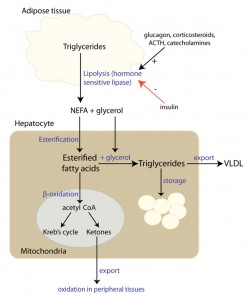Lipolysis of fat stored as triglycerides in adipose tissue occurs in response to increasing energy demands that cannot be adequately supplied by glucose. Hormones, such as glucagon, catecholamines, ACTH, corticosteroids and growth hormone, stimulate hormone-sensitive lipase, whereas insulin inhibits this enzyme. Lipolysis of triglycerides releases NEFAs (which are usually long-chain fatty acids) and glycerol. Glycerol is taken up by cells and used for glucose production or can be used to re-form triglycerides. NEFAs are water-insoluble and are transported bound to albumin. Once taken up by hepatocytes, NEFAs are esterified. The esterified fatty acids then have several fates:
1) They can recombine with glycerol to form triglycerides, which are packaged into VLDL. The VLDL are exported from the liver or (if produced in excess) are stored as fat within the hepatocyte (eventually causing lipidosis).
2) They can enter the mitochondria (in a reaction that requires carnitine) and be used for energy production (through the Kreb’s cycle) or ketone formation. Within the mitochondria, esterified fatty acids undergo β-oxidation to acetyl CoA. Acetyl CoA combines with oxaloacetate in the Kreb’s cycle (tricarboxylic acid cycle) to form citrate. Continued oxidation in this cycle leads to energy (ATP) production. If oxaloacetate supplies are low (oxaloacetate is used as a substrate for gluconeogenesis in states of negative energy balance), acetyl CoA is then used to form ketones.

